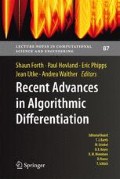Abstract
Automatic Differentiation techniques are typically derived based on the chain rule of differentiation. Other methods can be derived based on the inherent mathematical properties of generalized complex numbers that enable first-derivative information to be carried in the non-real part of the number. These methods are capable of producing effectively exact derivative values. However, when second-derivative information is desired, generalized complex numbers are not sufficient. Higher-dimensional extensions of generalized complex numbers, with multiple non-real parts, can produce accurate second-derivative information provided that multiplication is commutative. One particular number system is developed, termed hyper-dual numbers, which produces exact first- and second-derivative information. The accuracy of these calculations is demonstrated on an unstructured, parallel, unsteady Reynolds-Averaged Navier-Stokes solver.
Access this chapter
Tax calculation will be finalised at checkout
Purchases are for personal use only
References
Bartholomew-Biggs, M.C.: Using forward accumulation for automatic differentiation of implicitly-defined functions. Computational Optimization and Applications 9, 65–84 (1998)
Clifford, W.K.: Preliminary Sketch of Biquaternions. Proc. London Math. Soc. s1-4(1), 381–395 (1871). DOI 10.1112/plms/s1-4.1.381. URL http://plms.oxfordjournals.org/cgi/reprint/s1-4/1/381.pdf
Deakin, M.A.B.: Functions of a dual or duo variable. Mathematics Magazine 39(4), 215–219 (1966). URL http://www.jstor.org/stable/2688085
Eastham, M.S.P.: 2968. on the definition of dual numbers. The Mathematical Gazette 45(353), 232–233 (1961). URL http://www.jstor.org/stable/3612794
Fike, J.A., Alonso, J.J.: The development of hyper-dual numbers for exact second-derivative calculations. In: AIAA paper 2011-886, 49th AIAA Aerospace Sciences Meeting (2011)
Fike, J.A., Jongsma, S., Alonso, J.J., van der Weide, E.: Optimization with gradient and hessian information calculated using hyper-dual numbers. In: AIAA paper 2011-3807, 29th AIAA Applied Aerodynamics Conference (2011)
Griewank, A.: Evaluating Derivatives: Principles and Techniques of Algorithmic Differentiation. No. 19 in Frontiers in Appl. Math. SIAM, Philadelphia, PA (2000)
Hudson, R.W.H.T.: Review: Geometrie der Dynamen. Von E. Study. The Mathematical Gazette 3(44), 15–16 (1904). URL http://www.jstor.org/stable/3602894
Kantor, I., Solodovnikov, A.: Hypercomplex Numbers: An Elementary Introduction to Algebras. Springer-Verlag, New York (1989)
Lai, K.L., Crassidis, J.L.: Extensions of the first and second complex-step derivative approximations. J. Comput. Appl. Math. 219(1), 276–293 (2008). DOI http://dx.doi.org/10.1016/j.cam.2007.07.026
Leuck, H., Nagel, H.H.: Automatic differentiation facilitates OF-integration into steering-angle-based road vehicle tracking. IEEE Computer Society Conference on Computer Vision and Pattern Recognition 2, 2360 (1999). DOI http://doi.ieeecomputersociety.org/10. 1109/CVPR.1999.784659
Martins, J.R.R.A., Sturdza, P., Alonso, J.J.: The connection between the complex-step derivative approximation and algorithmic differentiation. In: AIAA paper 2001-0921, 39th Aerospace Sciences Meeting (2001)
Martins, J.R.R.A., Sturdza, P., Alonso, J.J.: The complex-step derivative approximation. ACM Transactions on Mathematical Software 29(3), 245–262 (2003). DOI http://doi.acm.org/10.1145/838250.838251
Olariu, S.: Complex Numbers in N Dimensions, North-Holland Mathematics Studies, vol. 190. North-Holland, Amsterdam (2002)
Pecnik, R., Terrapon, V.E., Ham, F., Iaccarino, G.: Full system scramjet simulation. Annual Research Briefs, Center for Turbulence Research, Stanford University (2009)
Piponi, D.: Automatic differentiation, C\(++\) templates, and photogrammetry. Journal of graphics, GPU, and game tools 9(4), 41–55 (2004)
Price, G.B.: An Introduction to Multicomplex Spaces and Functions. Monographs and Textbooks in Pure and Applied Mathematics, New York (1991)
Rall, L.B.: Automatic Differentiation: Techniques and Applications, Lecture Notes in Computer Science, vol. 120. Springer, Berlin (1981). DOI 10.1007/3-540-10861-0
Walther, A., Griewank, A.: ADOL-C: A package for the automatic differentiation of algorithms written in C/C\(++\). User’s Manual Version 2.1.12-stable (2010)
Acknowledgements
This work was funded, in part, by the United States Department of Energy’s Predictive Science Academic Alliance Program (PSAAP) at Stanford University.
Author information
Authors and Affiliations
Corresponding author
Editor information
Editors and Affiliations
Rights and permissions
Copyright information
© 2012 Springer-Verlag Berlin Heidelberg
About this paper
Cite this paper
Fike, J.A., Alonso, J.J. (2012). Automatic Differentiation Through the Use of Hyper-Dual Numbers for Second Derivatives. In: Forth, S., Hovland, P., Phipps, E., Utke, J., Walther, A. (eds) Recent Advances in Algorithmic Differentiation. Lecture Notes in Computational Science and Engineering, vol 87. Springer, Berlin, Heidelberg. https://doi.org/10.1007/978-3-642-30023-3_15
Download citation
DOI: https://doi.org/10.1007/978-3-642-30023-3_15
Published:
Publisher Name: Springer, Berlin, Heidelberg
Print ISBN: 978-3-642-30022-6
Online ISBN: 978-3-642-30023-3
eBook Packages: Mathematics and StatisticsMathematics and Statistics (R0)

